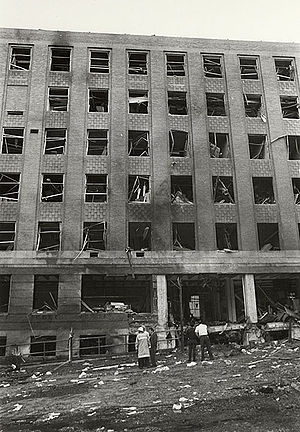The Oak Tree
I took a picture of the Oak Tree…

…so you can join me in the shade.
a blog by Joshua Wachuta
I took a picture of the Oak Tree…

…so you can join me in the shade.

In August, 1970, two unrelated explosions tore through quiet nights on different sides of the globe. Neither took place in a war zone. Each was carried out by people supposedly dedicated to non-violence, but each group felt that nothing less than an explosion could achieve its goals. One explosion did what its detonators hoped. One did not. Both are largely forgotten.
The first explosion took place in Iceland. Government officials had embarked on a development project for the northern Þingeyjarsýsla region that involved building a dam across the Laxá River. Local residents were dismayed. They stood to lose their land, livelihood, and countryside beneath the dam’s reservoir. The environment was also at stake. The Laxá was one of Iceland’s best fishing streams, and its name literally means “Salmon River.” A dam would have blocked the salmon migration and irrevocably changed the river’s ecology. Quickly, farmers and fishermen united in a legal battle to block the dam. Their efforts were fruitless. Construction continued, and it seemed that only one option remained.
Late on the night of August 7, 1970, over two-hundred local residents gathered at the river. They dug holes in the dam’s foundations, filled them with dynamite, and, ensuring that no people or animals were in sight, blew the dam to pieces. The following day, everyone in the community called the police to claim responsibility for the incident. Hearings were held, sixty-five people were convicted, but their fines were overturned by Iceland’s Supreme Court. One conspirator was ultimately elected to parliament. The dam was never rebuilt.
The second explosion occurred in the United States. Students at the University of Wisconsin-Madison had been protesting the United States’ war in Vietnam for several years. Protests had started nonviolently, but police had responded brutally at some demonstrations, beating students. By the end of the decade, the FBI had even infiltrated student organizations. Many protests centered on the Army Mathematics Research Center (AMRC), which occupied three floors of Sterling Hall on the UW-Madison campus. Students suspected AMRC of conducting research to further the Vietnam War, and many wanted it closed. The University of Wisconsin, however, had no intention of banishing the federally funded research and the respected mathematicians it brought to Madison. To a few war protesters, it seemed that only one option remained.
Before dawn on August 24, 1970, four anti-war activists detonated a homemade one ton bomb in a van parked outside Sterling Hall. They set off the explosion at 3:42 AM, hoping that the building would be empty, but it was not. A post-doctorate physics researcher with no connection to AMRC was killed, four others were injured, and over $2.1 million worth of property damage was done, mostly to the UW physics department on Sterling Hall’s lower floors. Upstairs, the Army Mathematics Research Center escaped with little damage. The four perpetrators fled, three were eventually caught and sentenced to short prison terms, the fourth was never apprehended. The Vietnam War continued for five more years.
So it happened that two nonviolent activist groups turned to explosive tactics in August 1970. The Laxá River campaign succeeded in its agenda. The Sterling Hall bombing did not. It is tragic that even in two established democracies like Iceland and the United States, underprivileged groups sometimes see no means but violence to make themselves heard. It is even worse in recent democracies—just look at this month’s headlines about explosions in Baghdad. Spreading democracy to Iraq at the point of a gun is no way to get people in there to settle their differences peacefully. Indeed, using violence to advance any nonviolent agenda always leads to terrible risks. As the Sterling Hall bombing made clear, even violence that purpotrators consider well-intended is prone to unintended consequences. Moreover, the unpredictability of violence can render it useless at achieving intended results. The Sterling Hall bombers should have known they couldn’t end a war by blowing something up. Wars end with treaties, not explosions.
It seems like everyone is on Facebook. Almost everyone. I’m one of the dwindling holdouts, a child of the web who builds computers and designs websites but who doesn’t see the attraction of jumping on the social networking bandwagon. I’m not the only holdout. The media has been quick to pounce on Facebook and similar sites over issues like lost privacy and cyber-stalking, and while I think these issues are little more than network ratings fodder, others have taken them to heart. My grievance with Facebook is more fundamental, not at heart a problem with what Facebook does, but a problem with what Facebook is—a monolithic private company that millions of people have chosen to facilitate the most important thing in their lives: their relationships.
“We are building Facebook to make the world more open and transparent,” proclaims the Facebook Principles page. “Facebook,” it continues, “promotes openness and transparency by giving individuals greater power to share and connect.” The page continues to set forth ten principles, which are in truth nothing but marketing buzzwords struck into idealistic sentences that reveal almost nothing about what commitments or services Facebook actually provides. What does Facebook provide? Contradictions, certainly. Click over to the Privacy Policy, also titled Facebook Principles, and you’ll see that instead of ten principles, “Facebook follows two core principles” introduced with the sentence, “We built Facebook to make it easy to share information with your friends and people around you.” This is a little less idealistic than the last page, but more immediately helpful. Facebook is a service that allows people to share information with the people around them.
People, or so I recall, have mouths for just this purpose.